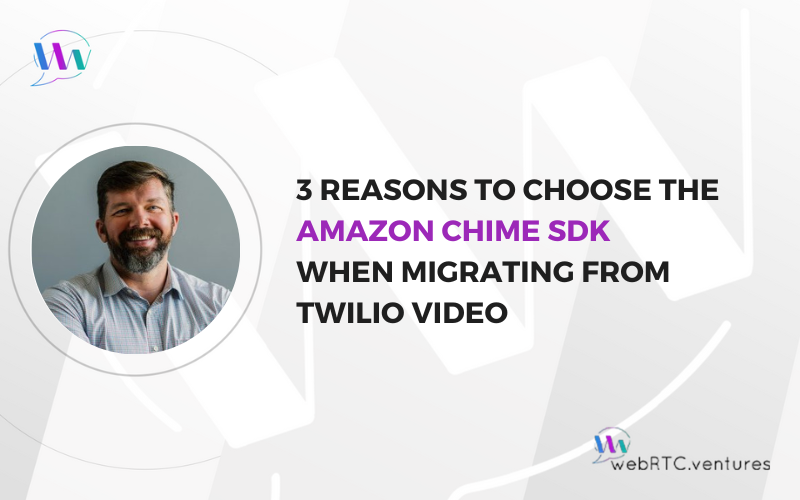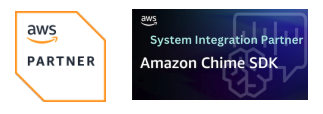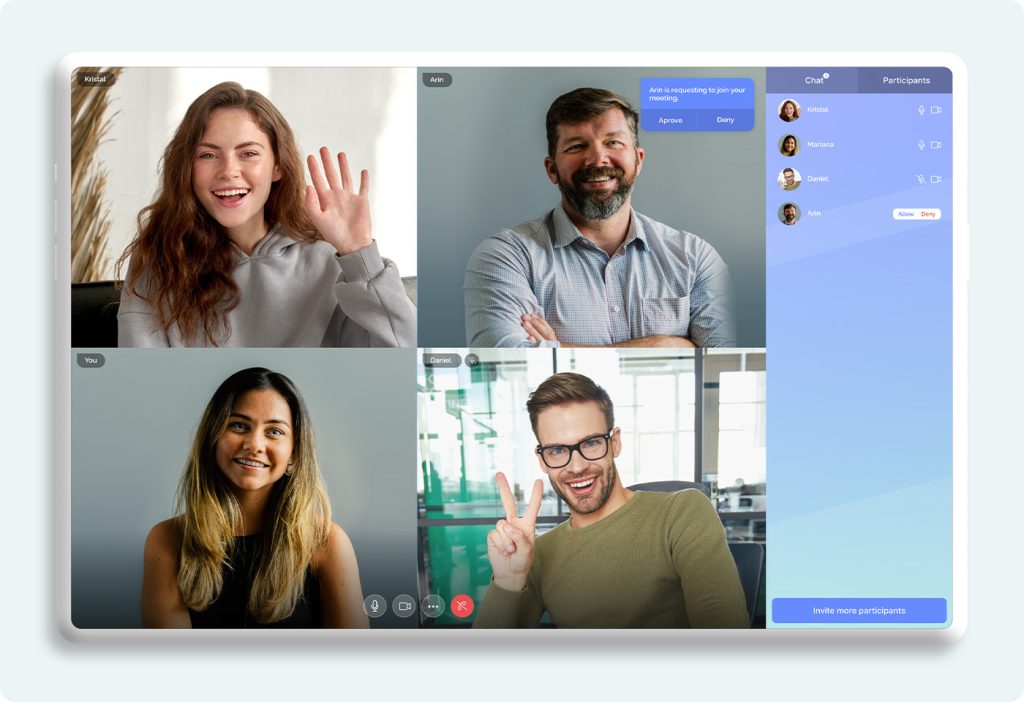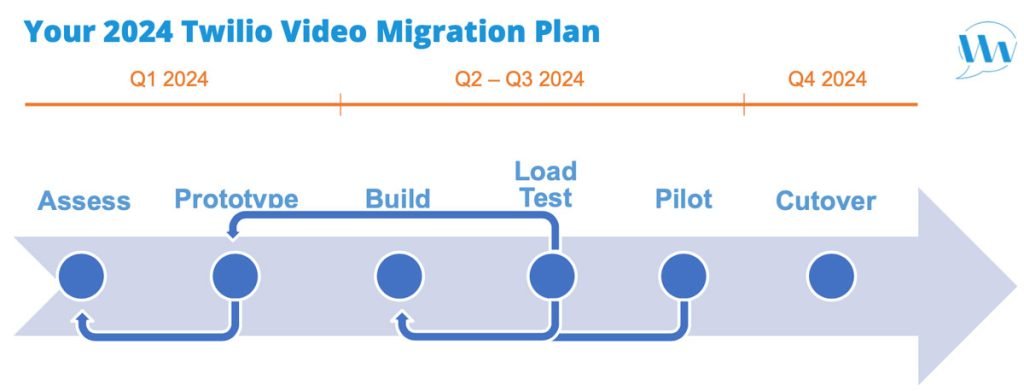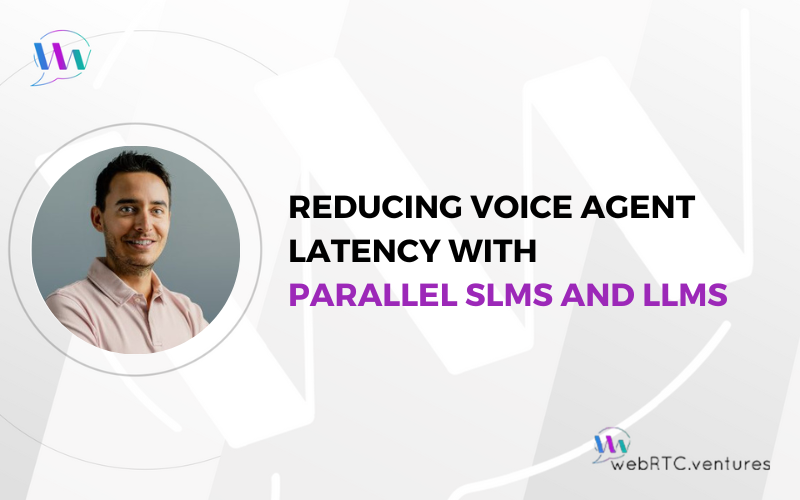Many companies are considering how to gracefully transition from Twilio Video and where to go before it sunsets in December 2024. Earlier this month, I hosted a webinar on this subject with special guests from our expert WebRTC.ventures team. You can find the webinar video and slides, links to presentation resources, and a migration plan timeline on our Migrating From Twilio Video Resource page.
There are many great Communications Platform as a Service (CPaaS) options out there to choose from – and open source media servers, as well. Today, I will review 3 reasons why you might choose the Amazon Chime SDK when transitioning from Twilio Programmable Video.
For more information, you can also visit:
- Go live and go big with the Amazon Chime SDK (WebRTC.ventures)
- Video Chat SDK – Amazon Chime SDK (AWS)
Reason #1: Built on AWS
If you’re of a certain age, and I guess I am, then you know the old business joke: “nobody gets fired for choosing IBM.” When a brand is so ubiquitous and offers such a wide range of services as IBM did back in the day, it’s a very safe choice. The same can definitely be said about AWS today. It truly powers so much of the web.
To get a little more specific on the benefits that the Amazon Chime SDK enjoys by being built on AWS:
- Global coverage. There’s no doubt that AWS has a tremendous global network. When many CPaaS providers talk about having global coverage for their media servers, it’s because they are running those servers on AWS. Twilio Video ran on AWS infrastructure, for example.
- Market stability. AWS is not going anywhere. You don’t need to worry about them shutting down like Twilio Programmable Video did.
- Enterprise level security and compliance. The sheer size of AWS means that they have been through all the audits and compliance checks that your organization has to go through, and probably more. In addition to their GovCloud offering which the Amazon Chime SDK can be deployed to, AWS is compliant to FedRAMP, HIPAA, PCI, SOC, and more.
WebRTC.ventures is proud to be part of the global community of developers who have attained an approval badge from Amazon Web Services as an official AWS Partner, in addition to our status as an Amazon Chime SDK System Integration Partner.
Reason #2: Incorporation in the Contact Center
AWS offers many different services, but one in particular that we want to call out is Amazon Connect cloud contact center and customer service software. At AWS re:Invent, it was announced that the Amazon Chime SDK and Amazon Connect would be more tightly integrated, with “Click to Call” capabilities for Amazon Connect being provided by the Amazon Chime SDK.
This is just one example of how the AWS network can often be leveraged together through streamlined integrations. Bringing voice and video into the contact center can be enabled easily for Amazon Connect users in the most straightforward use cases. Our team at WebRTC.ventures can build even more custom integrations using the same backend APIs.
If you use Amazon Connect already, or are considering it, then the Amazon Chime SDK is the natural choice for voice and video communications.
Reason #3: Flexibility and Integrations
Can you name every AWS service out there? I would be incredibly impressed.
One advantage of staying in the AWS cloud for your voice and video needs is more streamlined access to the whole network of AWS resources. We can help your team integrate with Amazon Interactive Video Service (Amazon IVS) for live streaming and e-commerce needs, with Amazon Lex for chatbots, or many other services. We can integrate any number of AWS-based AI services or easily integrate with external services for transcription, call summaries, call analytics, and more.
In our experience with the Amazon Chime SDK, we’ve also found it to be very flexible to work with. It uses WebRTC’s open standards, but doesn’t tie you into particular interface or architectural constructs. You have access to individual streams with which you can do anything you want and there’s a lot of flexibility in how you present the UI elements. That’s one reason we talked about in this case study of improving surgery outcomes using the Amazon Chime SDK for an audio listening application.
Bonus Reason: Pricing
Setting aside all the technical capabilities of the Amazon Chime SDK, there’s also two very good financial reasons to choose it for your migration away from Twilio Programmable Video:
1. Lower pricing
The public price is 57.5% lower on the Amazon Chime SDK vs Twilio ($0.0017 vs $0.0040).
2. AWS Cross-Product Discounts
Many companies have contracts that allow for discounts when they use more AWS products, formerly referred to as the Enterprise Discount Plan. Using the Amazon Chime SDK can be credited towards those spend requirements, which can simplify pricing and contracting for many organizations.
Our Video Call Starter Kit powered by the Amazon Chime SDK
Jumpstart your application with a set of standard video meeting tools that can be customized with greater functionality precisely for your use case.
Our Video Call Starter Kit is the distillation of the understanding we’ve gained from years building meeting tools for a wide variety of clients and use cases. This comprehensive set of meeting tools covers the most commonly requested features to ensure a swift and efficient launch of your virtual meeting tool. Check it out.
Don’t just migrate … Upgrade
For better or worse, you’re going to have to migrate your Twilio Programmable Video application in 2024. Why not make the best of it? Don’t look at this just as a media server migration. What else should you consider revamping?
This may be a good time to consider updates to your tech stack, UI and usability enhancements, as well as the addition of new features like AI integrations. If you’re moving to the Amazon Chime SDK, you can also use this as a time to consider other integrations in the AWS ecosystem like Amazon Connect.
Your 2024 Twilio Video Migration Plan
It was good that Twilio gave everyone a full year to migrate their applications. December 5, 2024 will come up faster than you expect! Based on our experience building live video and communication applications for nearly a decade for a wide range of industries and use cases, we know that building, deploying and testing these applications is often harder than people expect.
Below is our recommendation for your 2024 migration timeline, assuming that you are reading this in Q1 of 2024. If you are reading this later than that, then it’s even more critical that you contact us today so you have enough time to do a high quality cutover.
A successful migration away from Twilio Video should leave enough room for each of these steps:
- Assess
Take some time to compare not just features, but also billing models and technical implementations. We can help you compare multiple architectural considerations.
- Prototype
Every CPaaS implements a few things differently, even when the APIs look similar. You’ll want to prototype your new solution to discover the little things that may have a big impact on your specific workflow. We strongly recommend that you complete the Assessment and Prototyping phases in Q1 2024 in order to leave plenty of time for the hard work that follows.
- Build, Load Test, and Pilot!
After a successful prototype, you obviously need to do the full integration of your new media API into your application. Don’t forget to load test this new implementation and then pilot it with Alpha and Beta users to ensure it performs the way you expect both technically and from a usability perspective. Ideally, you’ll have all of Q2 and Q3 to dedicate to these efforts, so that you can deploy early and confidently in Q4. Make sure you start your pilot well before Q4 though so that you have time to incorporate feedback from users and load testing!
- Cutover
If you started early enough, we recommend doing your deployment early in Q4 2024. Don’t wait until December. Leaving some time allows a temporary rollback, if needed. You will also have better access to the support resources of your new CPaaS, our team, and even Twilio if needed, well before the rush of cutovers in November and December 2024 for those who didn’t get started early.
Don’t get caught at the back of the line!
We expect high demand for our team’s expertise this year. It’s crucial to contact us promptly to secure a slot for your project. Whether you’re seeking consulting and assessment exclusively or require assistance with the complete migration, deployment, and support of your new solution, we’re here to assist. Don’t hesitate—contact us today.
